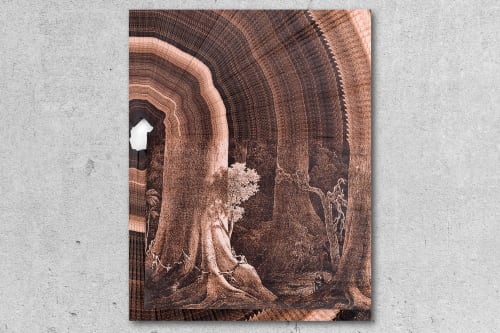Miler walks like a daring tightrope walker between opposing extremes. He stretches his ropes between engineering and art, between indigenous myths and the plans of a great city, between sacred jungles and gritty neighborhood corners. He knows how to connect those opposite shores, step by step, aware of the risks. But he always succeeds: in the end, a new reality awaits him in which technical skill, patience, and calculated audacity allow him to bring memorable works into this world.
That's why he takes a gigantic spool of newspaper and returns it to its botanical origin: it will be a tree again, a trunk, timber. He builds a mechanical wheel on the edge of the river and turns it into a dew and rain machine. And he displays bright, colorful balloons, looking light and festive on the surface, but he doesn't tell us that they hide a secret beneath their luster: they have a cement soul.
With Miler, you have to look beyond the facade. There's always a deeper or sardonic meaning veiled behind appearances.
On this occasion, we couldn't meet with Miler in person for this project. The distance imposed by the pandemic required us to understand each other from afar. We dreamed of this book through video calls, attended his workshop through a screen, and imagined the staging of his work in virtuality.
But Miler knows very well how to connect us with his essence. Always cordial, always willing, always attentive, he allowed us to enter his floor filled with wonders, and, broadcasting from his mobile phone, he gave us a guided tour, like an enlightened Renaissance man, through his creations. Without hurry, he told us with simplicity how his works are born from deep reflection, shaped by sophisticated mathematical calculations, and, with refined craftsmanship, acquire suggestive beauty. How about that mighty river that sprang from a tree and turned into deer antlers? Or that London newspaper that folded hundreds of times to form a new color wheel that brushes against eternity with news that no one remembers anymore? Miler seeks and always finds.
And along the way, other connections appeared: the concern for the environment, which is central to Miler's concepts and has led Celsia to restore watersheds throughout the country with native trees. Or the efficient use of energy and resources to generate it, like the wheel that Miler presented in Ecuador, moving on the water with the steps of passersby.
This new book/work in the Celsia series is a tribute to the artist and his career: to his inexhaustible energy in connecting opposites and giving material life to sublime concepts. We hope you enjoy this Origin very much and that, like us, you connect with the immense art of the tightrope walker, artist, and engineer, Miler Lagos.
CELSIA TEAM

